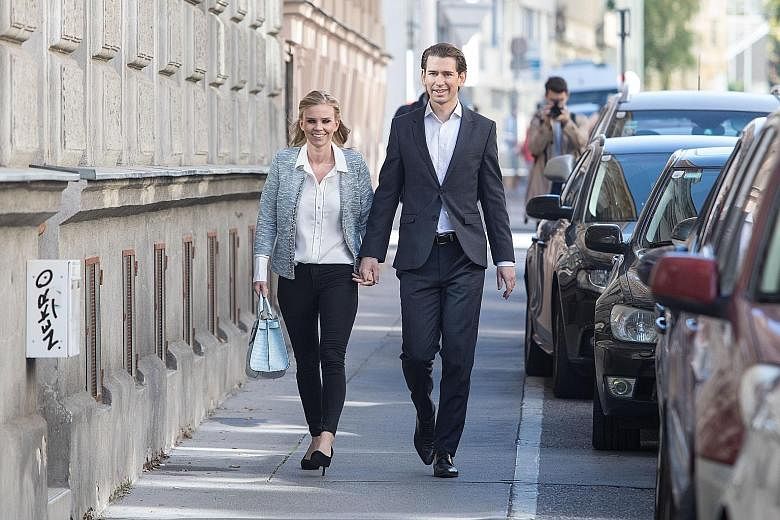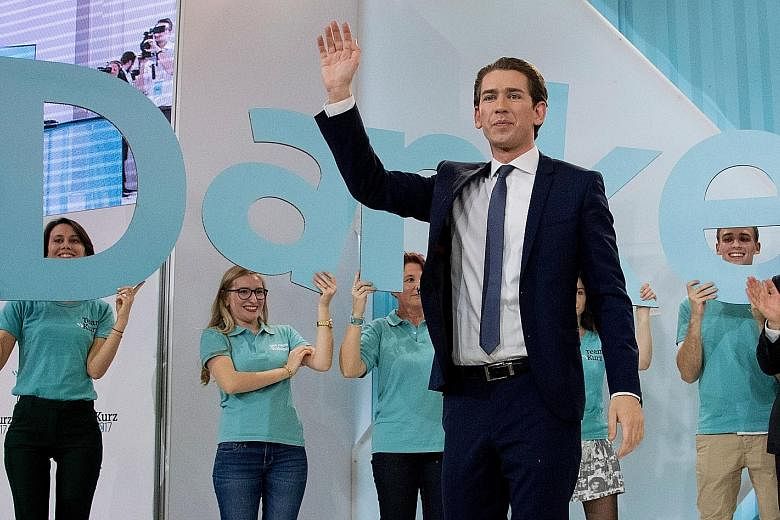NEW YORK • You know what they say: Three times is a trend.
Well, first Canada elected Mr Justin Trudeau Prime Minister at age 43 and he became something of a political marquee idol, thanks to his "because it's 2015" explanation of why his Cabinet was half women.
Then France elected Mr Emmanuel Macron president at 39, after he upended the establishment political parties with his En Marche! movement. Then he and Mr Trudeau began a bromance of sorts during the G-7 meeting in Sicily.
And now comes Mr Sebastian Kurz: the 31-year-old about-to-be chancellor of Austria and the youngest leader of a European Union state.
"Austria's answer to Macron and Trudeau?" CNN asked earlier this week.
In terms of policy, Mr Kurz swept to power on an anti-immigration platform. Unlike Mr Macron, he worked within an established party - the People's Party - to reshape it, as opposed to starting his own. Unlike Mr Trudeau, he had no legacy to live up to or exploit.
But in terms of presentation? Absolutely.
There has been a lot of talk in recent elections about dissatisfaction with politics as usual and one constant among all three men is that they crystallised the desire for change by connecting it to the look of generational change.
They do not dress in established conventions. They do not talk the same. And in the visual culture of a social media world, they understand how, increasingly, that can convince voters that they are not the same.
According to Professor Sylvia Kritzinger at the University of Vienna, the People's Party leader "says almost the same thing the rival Freedom Party was saying - things that would normally be labelled extremism about immigrants not being Austrians - but makes everyone feel comfortable with it".
That is not simply because of his age and unthreatening youthful appearance, but also because of the depth of his understanding of the power of a brand - an understanding shared by Mr Trudeau and Mr Macron.
Mr Kurz branded not only himself, but also his party. He changed its official colour from black to turquoise and referred to it as the New People's Party, the better to transform it from a familiar part of a coalition government to a "movement" (a word seemingly borrowed from Mr Macron) shaped in his own image.
At his election night rally, supporters wore turquoise jackets, shirts or sunglasses and carried turquoise balloons that said "Team Kurz". It was not the only thing he gave a specific look.
"Everything he does is styled to the last breath," said Mr Eugen Freund, a Social Democratic member of the European Parliament. "Not just on the fashion side. Everything is thought through - every movement of his hands, the way he gazes at people with a slight forward tilt of the head as if to indicate his attention. He does not leave anything to circumstance."
It began very early. In 2009, not long after Mr Kurz became leader of the youth wing of the party, he went on an image-ineering campaign with the tag line "Black is hot", featuring a picture of himself perched on the hood of a Hummer, in jeans, an untucked shirt and a come-hither look, surrounded by some equally satisfied-looking peers. It was broadly mocked, but it was also the beginning of a pattern.
Since becoming foreign minister in 2013 at 27, he has become known for his slim-line suits, a tendency to forgo ties (though he does wear them in debates and during state occasions), open collars and slicked-back hair.
On his website, Kurz2017, not one of the photographs of him - staring soulfully out a window at the future, hard at work and talking to "real" men and women - features a tie. Occasionally, he is shown in jeans and a pressed shirt, or a jacket, but never a T-shirt.
He also flies economy class, works at a standing desk, likes to tweet (he has 253,000 followers) and, like Mr Trudeau, will engage in selfies with fans for hours.
His website has videos of him biking, playing tennis and solo climbing a mountain under the stars, only to arrive at the metal cross on the summit as dawn breaks over the Alpine vista.
Indeed, Mr Gernot Bauer, national desk editor at the Austrian news magazine Profil, said Mr Kurz was like pop star Justin Bieber.
On Twitter, a fan compared the new chancellor to James Bond.
His critics use "minidictator" and even "Baby Hitler".
All of which underscored the message that Mr Kurz represented something new. That the newness seems to be, in fact, a swing to the right has been made palatable by the artful way Mr Kurz used his image to make the medicine go down.
NYTIMES


